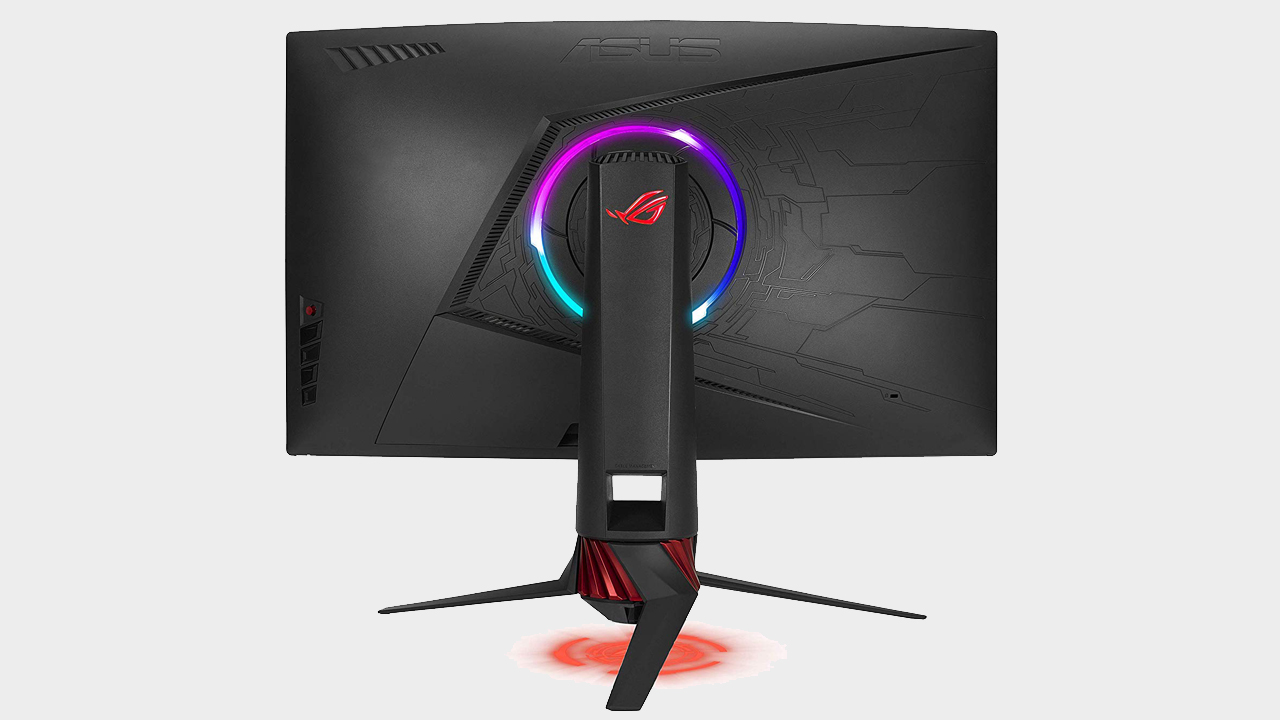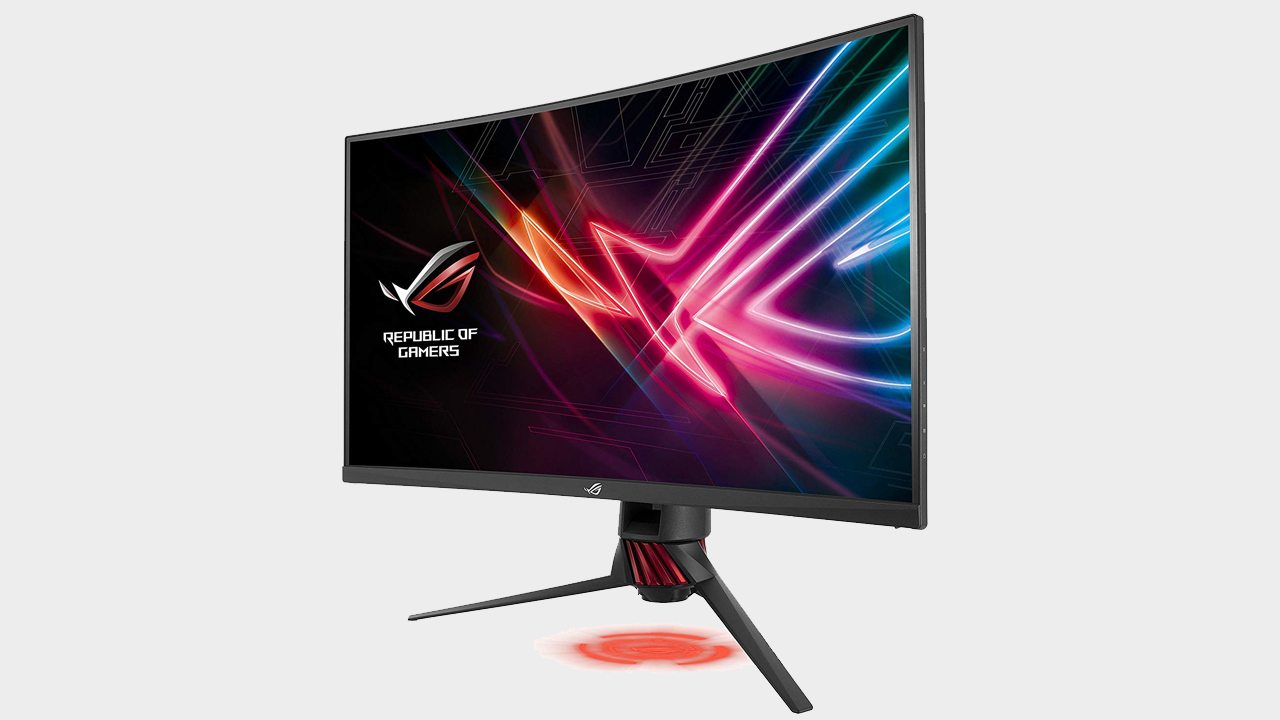Our Verdict
A solid curved gaming monitor defined by its strengths and weaknesses, both of which are noticeable and at the forefront of use. Good image quality and speed plays unreliable HDR and color with a loss of sight and any extended viewing angles.
For
- Crisp, detailed pictures
- 144Hz is very smooth
- Cool design
Against
- Loss of color and visibility at any angle
- Inconsistent HDR
- Sometimes overly saturated colours
PC Gamer's got your back
Price: $399/£300
Panel Size: 32-inch
Native Resolution: 2560x1440p
Panel Type: VA
Maximum Refresh: 144Hz
Response: 4ms
Contrast: 3,000:1
Display Inputs: 2 x HDMI 2.0; 2 x DP 1.2
Connectivity: 2 x USB 3.0, 1 x 3.5mm
VESA Mount: 100x100mm
Warranty: Three years
Always a big player in the gaming monitor arena, and always having potential to appear on our best gaming monitor list, Asus has now delivered the ROG Strix XG32VQR: a 32-inch, 1800R curved screen with a VA panel that runs at 1440p. On top of those stats, it does pump out some extra attractive numbers: a 144Hz refresh rate for smoothness in picture; and a 4ms response time for speedy play. Intriguingly, it also represents a step into the world of HDR and has a VESA DisplayHDR 400 certification. This is interesting as, while it's great to see HDR becoming increasingly common in gaming monitors, it's by no means a nailed-on success every time. Coming in at the $599 / £599 price mark, it's not really a budget option nor a truly premium one.
Pulling it out of the box, the monitor greets you with a chunky-but-stylish design that features some classic Asus ROG Strix adornments and stylistic quirks. The monitor's depth at its rear removes some of the initial elegance of the curved panel. But as it is an Asus design, it makes up for that with some cool twists in the base, and some wicked RGB lighting on the back and on the stand's underside. It really is a statement in design and is a cool looking bit of kit.
A curved gaming monitor has, by default, an immersion-increasing form factor through its curvature. Sitting in front of the XG32VQR with the panel wrapping around your field of vision is great, and the 32” size means it is well proportioned. On the rear, the quick-choose menu buttons are chunky and unmissable—in a helpful way, as they are incredibly easy to interact with—while the directional stick to navigate through the menu is user friendly and not fiddly.

In terms of menu features, there's plenty to service both your main rig or a secondary device like a console too. There's a range of game visual modes that are genuinely helpful (such as RPG, FPS and so on), a few different settings for blue light filters, shadow boost and, importantly, HDR and FreeSync. This is a FreeSync2 HDR enabled monitor with the FreeSync switched on by default. It does a superb job on the whole (more on that later), and the HDR settings are interesting ones: the built-in Asus HDR settings offer further flexibility away from the FreeSync HDR default (and 'off') settings, and this provides interesting and rather mixed results when playing games on the monitor. Cosmetically, there's some RGB settings that can make the lighting of the monitor a bit more exciting either on its own, or by combining it with your other devices through your machine via Aura Sync.
Near to the menu buttons are the monitor's array of ports: two HDMI 2.0s, one DisplayPort, two USB 3.0s, and an audio jack. Nothing vastly adventurous or stingy either, so you'll be well set for connectivity of an extra device alongside your main rig, if that's what you're into. All of these are hidden kept neatly behind a removable panel which can be taken off easily to input your connections then neatly put back to cover them up but also gently guide the wires through the cable management holes in the back and then through the stand. Handy.

Turning on the monitor and hooking it up, the first thing that greets you is the richness and depth of all the colours. There's a significant warmth to them no matter what shades or tones are on display—though it does get into overly saturated territory at times—and the blacks are quite deep too.
Turning to the games, I tried a decent handful: a mix of some recent big-hitters to test it with the latest and greatest, some particular titles that have visually-impressive environments, and a game or two that I'm currently playing as I'll be familiar with the pictures so am able to interrogate them closely. First up I took a stroll around Ancient Greece in Assassin's Creed Odyssey. This was glorious but also not perfect. The richness and depth in colour was seriously enjoyable stuff, particularly using the Asus HDR setting, even though this, in turn, made the overall image rather dark. A bit too dark, which is perhaps understandable given that HDR 400 is the minimum specification for HDR enabled monitors. Bafflingly the monitor's FreeSync HDR was better here but then you immediately lost depth in color and contrast. (This was a common theme in open world games, or at least open landscapes in worlds, and I tried a few to make sure of this—it generally seemed to be true over the course of them, and that constant tradeoff was a consistent quandary.)
One of these others was Ghost Recon Wildlands where the world was vivid and full of life. From frantic encounters to leisurely landscape 'walks' the environments were well colored and lush, with lighter shades perhaps coming out best. The HDR was present but less pronounced here, and upon closer scrutiny there were some sharpness issues too. Some of the images presented a graininess, and the edges of some UI elements were soft.

All the Metro titles test monitors in a range of ways, from detail and fidelity in Exodus to contrasts, tones and dark colors and spaces in 2033 and Last Light. Overall, the blacks here are deep, and the grays look decent in the Moscow metro system. There's a great contrast with anything that has color on screen, like in-game text, and this pops out well. The crispness of features, details and characters in Metro Exodus was generally good, and consistently portrayed with great fidelity, too. Turning to Apex Legend to test a contemporary and fast game, I'm treated to the 144Hz-buttery smoothness that the XG32VQR proclaims. The refresh rate very much comes to the fore here but is also teamed with that crisp picture quality. Covering ground quickly, flinching my vision from downsights to across the land, the smoothness is noticeable, certainly compared to a TV's 60Hz, and really shows the monitor's gaming pedigree.
However, there are two overriding shortfalls that persist over all my time with the XG32VQR. The first is the difficulty in using the various HDR settings from game to game. The FreeSync 2 HDR setting makes everything look a bit shiny and washed out (like a dusty fog is covering the picture) but also brighter, whereas the Asus gaming HDR setting is so much better for colors and contrasts, but is so rich it brings darkness to the fore. The silver lining to this is maybe an accidental flexibility, allowing you to choose an appropriate setting when in-game settings couldn't be set to optimal visual standards.
The second shortcoming is that of viewing angle problems and loss of image clarity and color. The XG32VQR lost a lot of color and useful viewing angle when, well, viewed at any angle, so positioning yourself and the monitor (and light sources) is a little trickier than it should be. Usually a curved monitor mitigates this, and is a selling point of it, so this was a bit disappointing.
A solid curved gaming monitor defined by its strengths and weaknesses, both of which are noticeable and at the forefront of use. Good image quality and speed plays unreliable HDR and color with a loss of sight and any extended viewing angles.



